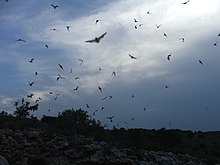
Cryptic rabies refers to infection from unrecognized exposure to rabies virus. It is often phylogenetically traced to bats. It is most often seen in the southern United States. Silver-haired bats (Lasionycteris noctivagans) and tricolored bats (Perimyotis subflavus) are the two most common bat species associated with this form of infection, though both species are known to have less contact with humans than other bat species such as the big brown bat. That species is common throughout the United States and often roosts in buildings and homes where human contact is more likely.[1][2]
- ^ Messenger, Sharon L.; Smith, Jean S.; Orciari, Lillian A.; Yager, Pamela A.; Rupprecht, Charles E. (February 2003). "Emerging Pattern of Rabies Deaths and Increased Viral Infectivity". Emerging Infectious Diseases. 9 (2): 151–154. doi:10.3201/eid0902.020083. PMC 2901935. PMID 12603983.
- ^ Messenger, Sharon L.; Smith, Jean S.; Rupprecht, Charles E. (15 September 2002). "Emerging Epidemiology of Bat-Associated Cryptic Cases of Rabies in Humans in the United States". Clinical Infectious Diseases. 35 (6): 738–747. doi:10.1086/342387. PMID 12203172.